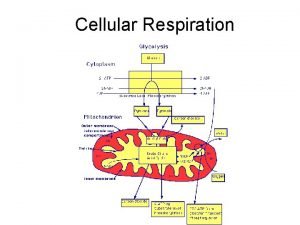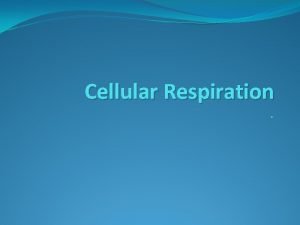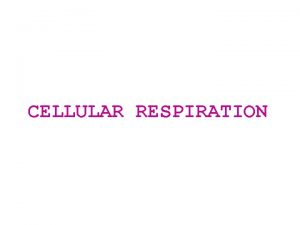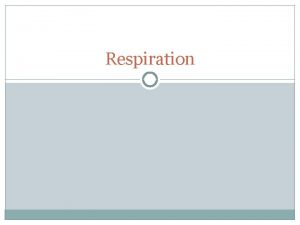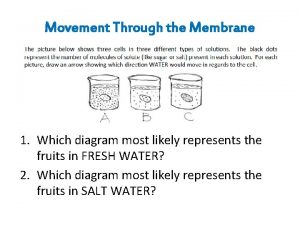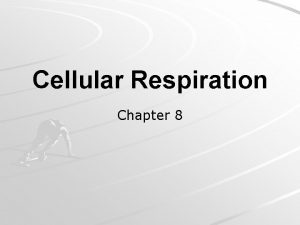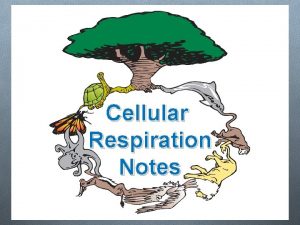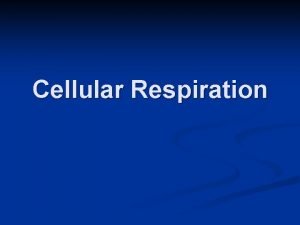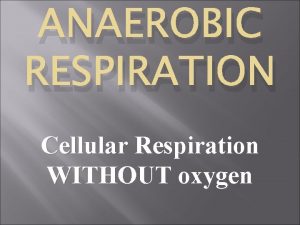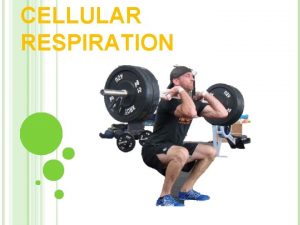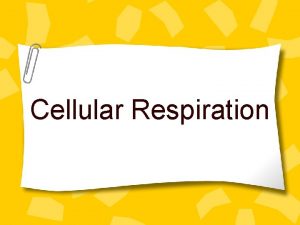Chapter 9 Notes Cellular Respiration Cellular Respiration Process

















- Slides: 17

Chapter 9 Notes Cellular Respiration

Cellular Respiration • Process by which energy stored in food inside the cell is released slowly as ATP 6 CO 2 + C 6 H 12 O 6 6 CO 2 + 6 H 2 O + 36 ATP

Anaerobic Respiration Aerobic Respiration

Anaerobic Respiration Does NOT use oxygen Aerobic Respiration

Anaerobic Respiration Aerobic Respiration Does NOT use oxygen Uses oxygen

Anaerobic Respiration Aerobic Respiration Does NOT use oxygen Makes lactic acid or CO 2 and ethyl alcohol Uses oxygen

Anaerobic Respiration Aerobic Respiration Does NOT use oxygen Makes lactic acid or CO 2 and ethyl alcohol Uses oxygen Makes CO 2 and H 2 O

Anaerobic Respiration Aerobic Respiration Does NOT use oxygen Makes lactic acid or CO 2 and ethyl alcohol Uses oxygen Makes CO 2 and H 2 O Makes 2 ATP

Anaerobic Respiration Aerobic Respiration Does NOT use oxygen Makes lactic acid or CO 2 and ethyl alcohol Uses oxygen Makes CO 2 and H 2 O Makes 2 ATP Makes 36 ATP

1 Glucose Glycolysis without O 2 2 Pyruvic Acid Fermentation 34 ATP animals Lactic Acid plant fungus Ethyl Acid CO 2 2 ATP with O 2 Krebs Cycle and Electron Transport Chain

ANAEROBIC RESPIRATION – no O 2 present 1) Glycolysis 2) Fermentation

ANAEROBIC RESPIRATION – no O 2 present 1) Glycolysis – in cytoplasm C 6 H 12 O 6 + 2 ATP 2 pyruvic acid + 4 ATP

ANAEROBIC RESPIRATION – no O 2 present 2) Fermentation a) Lactic Acid Fermentation (animals) 2 pyruvic acid + NADH lactic acid + NAD+ * Humans build up lactic acid in muscle cells when there is not enough O 2 present during exercise

ANAEROBIC RESPIRATION – no O 2 present 2) Fermentation b) Alcoholic Fermentation (plant and fungus) 2 pyruvic acid + NADH ethyl alcohol + CO 2 + NAD+ * used to produce bread and beer by yeast

AEROBIC RESPIRATION – O 2 present 1) Glycolysis 2) Krebs Cycle and Electron Transport Chain

AEROBIC RESPIRATION – O 2 present 1) Glycolysis – in cytoplasm C 6 H 12 O 6 + 2 ATP 2 pyruvic acid + 4 ATP

AEROBIC RESPIRATION – O 2 present 2) Krebs Cycle and Electron Transport Chain – in mitochondria 2 pyruvic acid + O 2 CO 2 + H 2 O + 34 ATP • • Large organisms need a lot of energy and aerobic respiration is more efficient (36 ATP) than anaerobic respiration (2 ATP) When exercising for long periods lactic acid is produced due to lack of oxygen, muscles feel tired because now only 2 ATP’s are produced instead of 36 ATP
 Complimentary processes
Complimentary processes Process of cellular respiration
Process of cellular respiration Steps 1
Steps 1 Cellular respiration is a complex process that
Cellular respiration is a complex process that Chapter 8 section 3: cellular respiration
Chapter 8 section 3: cellular respiration Chapter 9 cellular respiration harvesting chemical energy
Chapter 9 cellular respiration harvesting chemical energy Chapter 9 cellular respiration harvesting chemical energy
Chapter 9 cellular respiration harvesting chemical energy Chapter 9: cellular respiration: harvesting chemical energy
Chapter 9: cellular respiration: harvesting chemical energy Cellular respiration redox
Cellular respiration redox The gray-brown haze often found over large cities is called
The gray-brown haze often found over large cities is called Chemiosmosis steps
Chemiosmosis steps Types of respiration
Types of respiration Anaerobic respiration diagram
Anaerobic respiration diagram Why is cellular respiration important
Why is cellular respiration important What plant need for photosynthesis
What plant need for photosynthesis Cellular respiration reactants
Cellular respiration reactants Photosynthesis ewuation
Photosynthesis ewuation Starting materials for cellular respiration
Starting materials for cellular respiration

